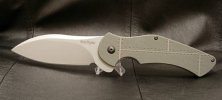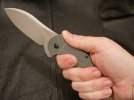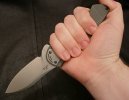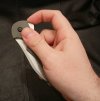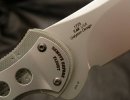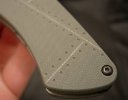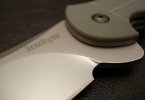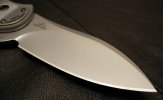- Joined
- Mar 21, 2005
- Messages
- 3,355
Here are some thoughts and pictures collected on the Kershaw JYD 2 that I had for a week on passaround.
Handle/Grip: The G10 provides a good level of grip without being too abrasive. The marks in the G10 that emulate the riveted sheet metal look on the smaller JYD and Tim’s custom JYD models are a nice touch. It keeps the styling cues of the line present but in a subtle way, looking nicer than plain scales would have. The shape of the handle is very comfortable. The thumb naturally settles in the dip on the top of the handle. The curves on the bottom combine with this to give good purchase without much pressure. Holding the knife in a hammer grip created some hotspots, mainly due to the clip. Using the knife for some food prep slicing (gripping with the hand rotated over and the index finder along the spine of the blade) was fine. Again, the profile of the handle allowed my hand to find a natural, comfortable position that provided solid grip without any undue pressure.
Blade: At it’s thickest part, I measured the blade stock to be 1/8”. The edge on the Sandvik was very keen. While the high bottom grind and swedge grind give the blade a thin appearance from some angles, I believe the width of the blade will provide good strength for the tip.
Cutting: Here’s what I cut with this knife – envelopes, blister pack for a PS2 controller, onions, peppers, mushrooms, newsprint, paper grocery bags and an cotton t-shirt. There were no issues cutting any of the above materials and no noticeable degradation of the edge after use. The vegetable slicing went well, and while a flat ground blade may have made things a bit faster I was happy with how this blade profile performed. Opening the blister pack was easy. The tip made good penetration on the plastic and moving the blade with a steady even pressure resulted in a clean cut with no interruption. Running a finger over the tip after these cuts did not reveal any dulling or deformation. I have used other knives with comparable steels for opening similar packs and did not always have an unblemished edge afterwards, so take that for what you will.
Opening/Closing: Flipping this knife open is a lot of fun and easy to do. I found myself flipping the knife a lot of the time when I was watching TV or at the computer over the past week. I found that what worked best for me was the place the tip my index finger over as much of the side of the tab closest to the pivot as possible. Once positioned there I just pulled my finger down along the handle and the blade popped open very easily. After the first few hours of handling the knife I thought that a little wrist action would be needed if I was holding the knife at or near a straight up position, but as the week went on and I practiced some more, I found that I could provide sufficient force with just my finger. If your grip and positioning were not optimal, or the knife was in your off hand, then a roll of the wrist will help, but the amount of movement needed isn’t much. The knife pivots very smoothly and the mass of the blade helps get it the rest of the way past a certain point. The knife does have a conventional stop pin. Rather, it appears to have 2 hidden stop pins in the pivot. The liner lock clicks solidly into place when the knife is opened. Closing the knife one-handed is easy. The liner stuck a little bit when trying to disengage it for the first 2 days, but after some more cycling that disappeared.
Construction: The liners on this knife are thick. If you’re one who doesn’t like linerlocks because they are too thin for you, I think you may be okay with this knife. A picture of the lockup can be seen the Kershaw Knives News Thread in the Blade Discussion Forum on page 19. The liners have cutouts to reduce weight. There were three cutouts on the non-locking side. I believe the locking side had only one, at the back end. There were a few spots where the alignment across the handle scales, liners and backspacer was not flush and even, but the variance was minimal, something you’d have to look closely at to see or run your finger over to feel. Other than that there weren’t any places where I had any issues wit the finish of the knife. I feel this knife is well constructed and solid, a sense conveyed in part by the fact that the knife is not that heavy but has a nice heft to it in the hand.
Overall: I liked the JYD 2 very much. In terms of design, quality and the fun of the flipper, it’s a great option. I might choose to buy the smaller JYD for my own EDC rather than this one, but my usual taste in EDC folders is for smaller knives, or ones that are slimmer if the blade is 3 1/2” or more. I say the JYD 2 is a definite thumbs up.
Thanks to Kershaw for providing the knife and thanks to Jeremy (nygiantsfan3342) for organizing the passaround.
Handle/Grip: The G10 provides a good level of grip without being too abrasive. The marks in the G10 that emulate the riveted sheet metal look on the smaller JYD and Tim’s custom JYD models are a nice touch. It keeps the styling cues of the line present but in a subtle way, looking nicer than plain scales would have. The shape of the handle is very comfortable. The thumb naturally settles in the dip on the top of the handle. The curves on the bottom combine with this to give good purchase without much pressure. Holding the knife in a hammer grip created some hotspots, mainly due to the clip. Using the knife for some food prep slicing (gripping with the hand rotated over and the index finder along the spine of the blade) was fine. Again, the profile of the handle allowed my hand to find a natural, comfortable position that provided solid grip without any undue pressure.
Blade: At it’s thickest part, I measured the blade stock to be 1/8”. The edge on the Sandvik was very keen. While the high bottom grind and swedge grind give the blade a thin appearance from some angles, I believe the width of the blade will provide good strength for the tip.
Cutting: Here’s what I cut with this knife – envelopes, blister pack for a PS2 controller, onions, peppers, mushrooms, newsprint, paper grocery bags and an cotton t-shirt. There were no issues cutting any of the above materials and no noticeable degradation of the edge after use. The vegetable slicing went well, and while a flat ground blade may have made things a bit faster I was happy with how this blade profile performed. Opening the blister pack was easy. The tip made good penetration on the plastic and moving the blade with a steady even pressure resulted in a clean cut with no interruption. Running a finger over the tip after these cuts did not reveal any dulling or deformation. I have used other knives with comparable steels for opening similar packs and did not always have an unblemished edge afterwards, so take that for what you will.
Opening/Closing: Flipping this knife open is a lot of fun and easy to do. I found myself flipping the knife a lot of the time when I was watching TV or at the computer over the past week. I found that what worked best for me was the place the tip my index finger over as much of the side of the tab closest to the pivot as possible. Once positioned there I just pulled my finger down along the handle and the blade popped open very easily. After the first few hours of handling the knife I thought that a little wrist action would be needed if I was holding the knife at or near a straight up position, but as the week went on and I practiced some more, I found that I could provide sufficient force with just my finger. If your grip and positioning were not optimal, or the knife was in your off hand, then a roll of the wrist will help, but the amount of movement needed isn’t much. The knife pivots very smoothly and the mass of the blade helps get it the rest of the way past a certain point. The knife does have a conventional stop pin. Rather, it appears to have 2 hidden stop pins in the pivot. The liner lock clicks solidly into place when the knife is opened. Closing the knife one-handed is easy. The liner stuck a little bit when trying to disengage it for the first 2 days, but after some more cycling that disappeared.
Construction: The liners on this knife are thick. If you’re one who doesn’t like linerlocks because they are too thin for you, I think you may be okay with this knife. A picture of the lockup can be seen the Kershaw Knives News Thread in the Blade Discussion Forum on page 19. The liners have cutouts to reduce weight. There were three cutouts on the non-locking side. I believe the locking side had only one, at the back end. There were a few spots where the alignment across the handle scales, liners and backspacer was not flush and even, but the variance was minimal, something you’d have to look closely at to see or run your finger over to feel. Other than that there weren’t any places where I had any issues wit the finish of the knife. I feel this knife is well constructed and solid, a sense conveyed in part by the fact that the knife is not that heavy but has a nice heft to it in the hand.
Overall: I liked the JYD 2 very much. In terms of design, quality and the fun of the flipper, it’s a great option. I might choose to buy the smaller JYD for my own EDC rather than this one, but my usual taste in EDC folders is for smaller knives, or ones that are slimmer if the blade is 3 1/2” or more. I say the JYD 2 is a definite thumbs up.
Thanks to Kershaw for providing the knife and thanks to Jeremy (nygiantsfan3342) for organizing the passaround.

